Definition of pointer:
- The need to use pointers to save an address
- Scene transfer and offset used by pointer
Is to save the address and pass the parameters
#include <stdio.h> int main() { int i=5; int* i_pointer=&i; }
Pointer variables of type int can only correspond to int variables (what model corresponds to what)
Pointer variable is used to save address and get variable address
The definition format of pointer is as follows
Base type * Pointer variable name
The type is preceded by the variable name
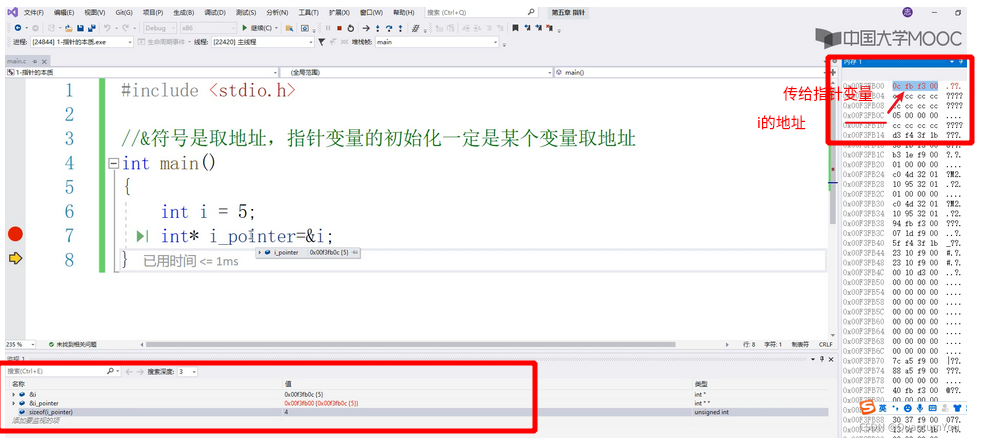
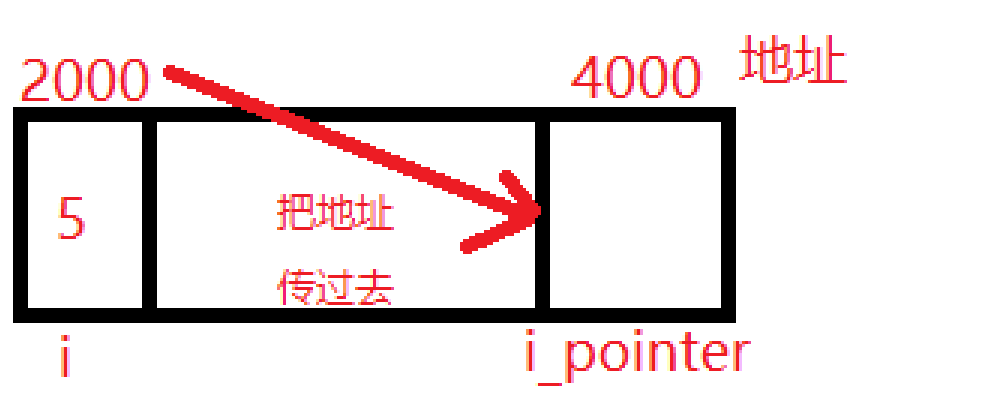
Basically, you can pass it like this, and then * value
Some questions about * and &?
If it has been implemented
pointer_ 1 = & A, here's the address
So & * pointer_ What does 1 mean?
&The priority is the same as * but in order from right to left
First * pointer_1 value, equivalent to * & A
Take out the value of variable a (5), so follow & A (5)
&* pointer_ 1 equivalence and &a# are addresses
So what does * & a mean?
First &a take out the address, that is, the pointer_1 same
In the * value operation, take out the variable a(5)
*&A is equivalent to a, both of which are values
- Summary: * value (dereference) & Address (Reference)
For array pointers
such as
#define _CRT_SECURE_NO_WARNINGS #include <stdio.h> #include <stdlib.h> int main() { int a[5]={1,2,3,4,5}; int* p;//Value a pointer variable, and the result is also its base type (here is int) p=a; //First address printf("%d\n",*p); getchar(); system("pause"); return 0; }
This situation
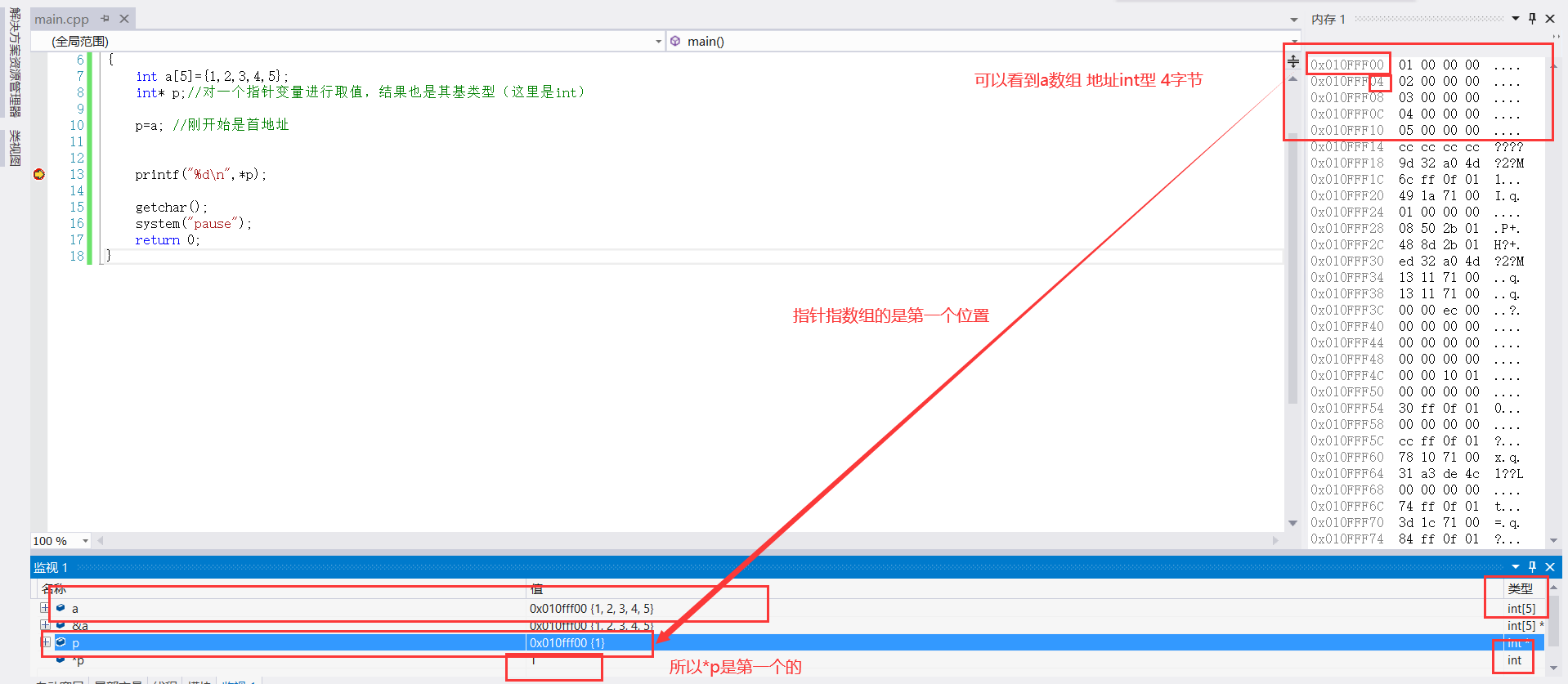
In this case, the single pointer refers to the starting position of the array, which is a[0]
How do you want to print, use a loop
for (int i = 0; i < 5; i++) { printf("%d\n",*(p+i)); }
Pay attention to ensure that the two side types are the same: a [] array {p=a} A is also the initial position of the array
If & A is the initial address a[1] of the a array, take the address again
So you can't use p = & A
The pointer increases and decreases automatically
i + + and + + i have been seen before
What about * p + +, * p -- * + + p
#define _CRT_SECURE_NO_WARNINGS #include <stdio.h> #include <stdlib.h> int main() { int a[3]={2,7,8}; int *p; int j; p=a;//Let pointer variable p Point to the beginning of the array j=(*p)++;// printf("a[0]=%d,j=%d,*p=%d\n",a[0],j,*p); getchar(); system("pause"); return 0; }
Try to say the values of a[0] *p and j
Answer: first (* p) access the space at the beginning of the 2 array
The overall j (* p) + + change points to the next spatial value, that is, the space with the numerical value of 3
At this time, the initial position address of the array remains unchanged, and the value in it becomes 3
So a[0] is 3 * p and the whole becomes 3
At this time, let's talk about the value of J. first, let's look at if j=i + +; i=1; What is j equal to after the end?
1. First of all, take it out separately and say + + i and i + +, which mean the same, that is, i=i+1.
2. As an operator, it is a=i + + or a=++i. The situation is different.
First say a=i + +. This operation means to assign the value of i to a first, and then execute i=i+1;
And a = + i, which means that i=i+1 is executed first, and then the value of i is given to a;
For example, if i=4 at first.
Then, after executing the statement a=i + +, a=4, i=5;
Then, after executing the statement a=++i, i=5, a=5;
Similarly, i -- and -- i are used the same way.
Link: https://www.zhihu.com/question/19811087/answer/207494860
If you pull it out alone, it will be + 1, and the operator will be transformed
j=i++; Assign value first, j=1; Then i++=2; i=2;
j=++i; First i+1; i=2; Then assign value, j=2;
So the j value of the above code
j=(*p)++;
(* p) + + value 3 initial position of address array
But j = assign value first, j = (* P) = assign value at the beginning, so * p =2
Later operation + +
*p is 3
Replace the value of the address of array a[0]
Pointers and one-dimensional arrays
#define _CRT_SECURE_NO_WARNINGS #include <stdio.h> #include <stdlib.h> void change(char d[]) { d[0]; } int main() { char c[10]="hello"; change(c);
getchar(); system("pause"); return 0; }
For example, this function call is
d [] is actually an i pointer array like * d
But this d[] is not done, so arrays should not be placed in the formal parameters of the function
Just put a pointer variable
void change (char *d)
Cannot get array length
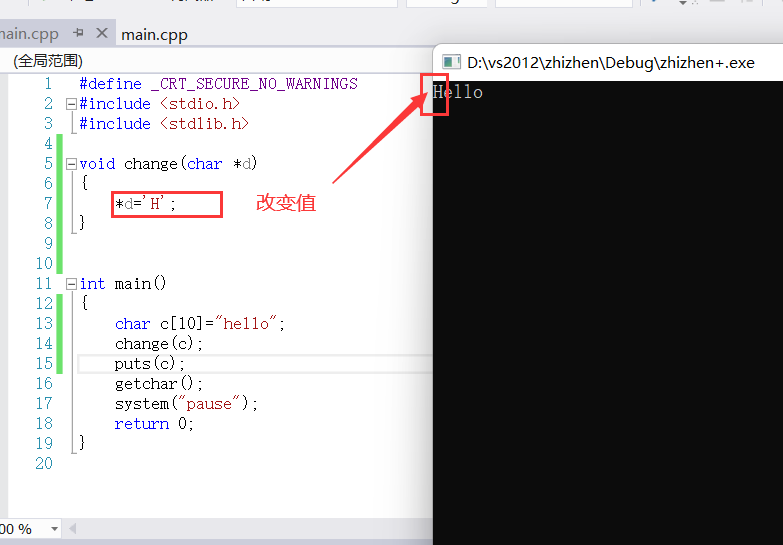
void change(char *d) { *d='H'; d[1]='E'; *(d+2)='L' }
This can change the value
d[1] is passed to the function by c[1]
Pass the address of c directly to the function parameter pointer d
Equal to d=c, same address
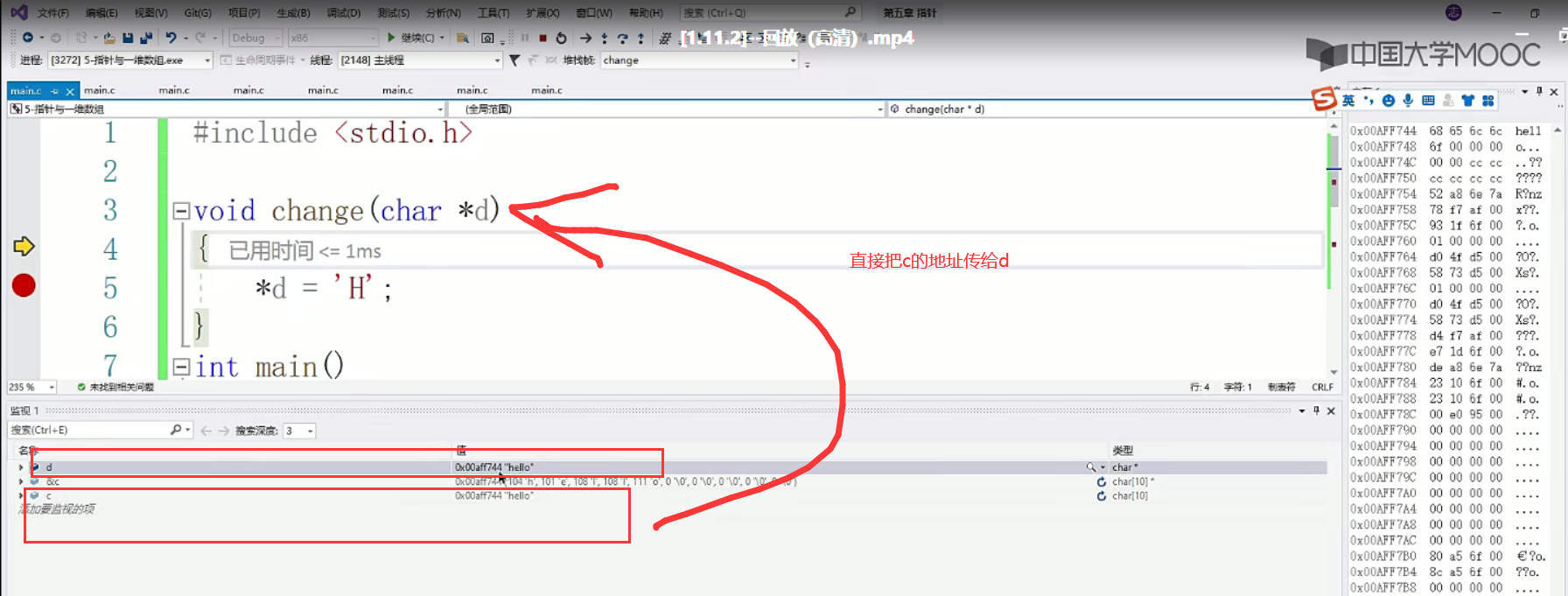
Dynamic memory request malloc
Request 5*sizeof(int)=20 bytes
The array is defined at the beginning, and the data is placed in the stack space
Process address space: stack
explain : the size of stack space is determined at compile time. If the size of space used is uncertain, heap space should be used.
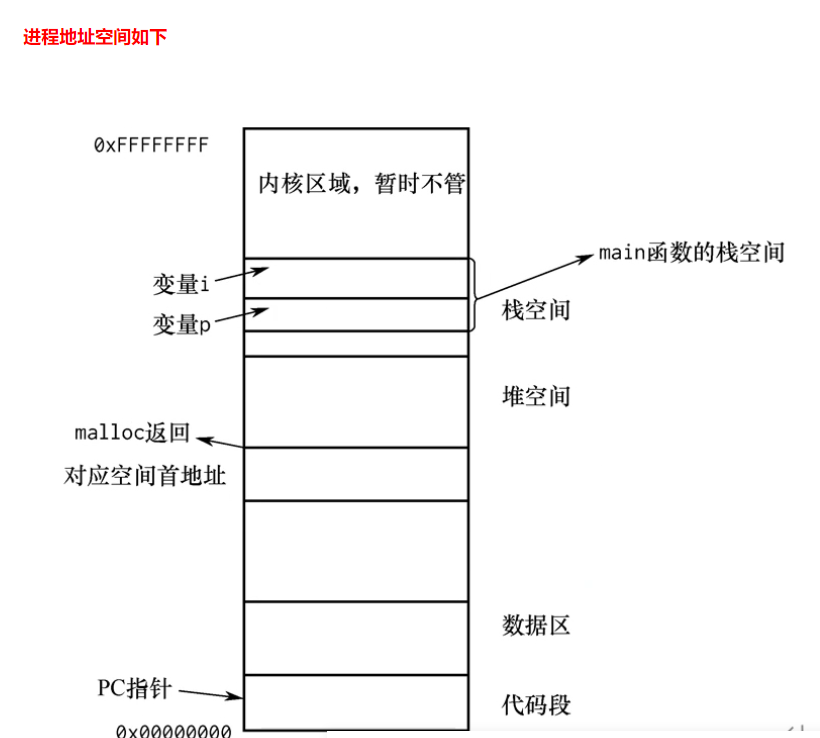
int i; //How much space to apply for scanf("%d",&i); char* p; p=(char*) malloc(i); //malloc Dynamic application space //malloc The unit of space requested is bytes //malloc Returned is void*Type pointer //(char*) Strong rotation int *p1; p1=(int*)malloc(20);//malloc The request is bytes. Here, 20 bytes are requested //1 individual int It takes 4 bytes, so it is equal to 5 bytes applied int,be equal to a[0]-a[4]
Total application code:
#define _CRT_SECURE_NO_WARNINGS #include <stdio.h> #include <stdlib.h> #include <string.h> int main() { int i; //How much space to apply for scanf("%d",&i); char* p; p=(char*) malloc(i); //malloc Dynamic application space //malloc The unit of space requested is bytes //malloc Returned is void*Type pointer //(char*) Strong rotation strcpy(p,"malloc success"); puts(p); getchar(); system("pause"); return 0; }
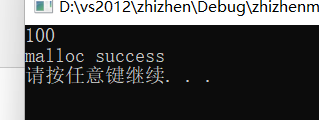
Apply for 100 bytes for "malloc success", as shown in the figure:

But also free memory
The pointer p offset error is recorded here
int i; //How much space to apply for scanf("%d",&i); char* p; p=(char*) malloc(i); //malloc Dynamic application space p++; strcpy(p,"malloc success");
puts(p);
Here, p + + only wants to print the following "alloc success", but free(p) will report an error
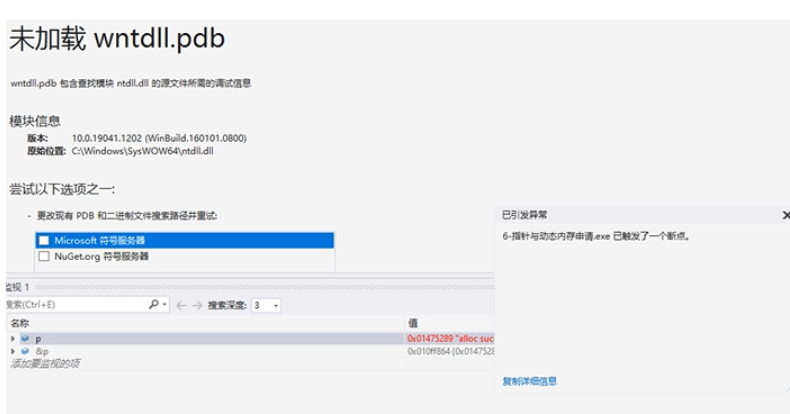
You can write a * p1
char* p; char *p1; p=(char*) malloc(i); //malloc Dynamic application space //malloc The unit of space requested is bytes //malloc Returned is void*Type pointer //(char*) Strong rotation p1++; strcpy(p,"malloc success"); strcpy(p1,p); puts(p); free(p);
last
free(p) ; p=NULL ; Release operation
After release, p is a wild pointer, so there is no point
So p=NULL;
If the p value is not NULL, it is called a wild pointer
Note: the heap space will not be released with the end of the sub function, but must be free by itself
Stack space and heap space difference
Stack space:
Take an example:
#define _CRT_SECURE_NO_WARNINGS #include <stdio.h> #include <stdlib.h> char* printf_stack() //char* return char* type { char c[17]="i am print_stack"; puts(c); //Can print normally return c; //return char* c } int main() { char* p; p=printf_stack();//p=c; puts(p); getchar(); system("pause"); return 0; }

Function inside the normal printing, the following main function inside the normal printing
The reason is that the stack (automatic space allocation) function will be released automatically after it is completed
Abnormal printing
Because puts(p) takes up stack space at this time
Heap space:
#define _CRT_SECURE_NO_WARNINGS #include <stdio.h> #include <stdlib.h> #include <string.h> char* printf_stack() //char* return char* type { char c[17]="i am print_stack"; puts(c); //Can print normally return c; //return char* c } char* printf_malloc() //char* return char* type { char* p=(char*)malloc(30);//Request heap space memory strcpy(p,"I am print_malloc"); puts(p); return p; //return char* p } int main() { char* p; p=printf_stack(); //puts(p); p=printf_malloc(); puts(p); getchar(); system("pause"); return 0; }

This is because: the application heap space will not end because of the end of the function, and will always be available unless free
Let's take an example:
Input an integer number, then apply for the memory of the corresponding size space, and then read a string. The input length of the string is less than the size of the initial input integer number, and finally output the input string (it is unnecessary to consider that the input string is too long and exceeds the memory size);

#define _CRT_SECURE_NO_WARNINGS #include <stdio.h> #include <stdlib.h> #include <string.h> int main() { int n; //How much space to apply for scanf("%d",&n); char* p; p=(char*)malloc(n); char c; scanf("%c",&c); gets(p); puts(p); getchar(); system("pause"); return 0; }
Let's mainly talk about char c here; scanf("%c",&c);’
Both puts and gets use buffers
Because there is scanf("%d",i) in front, scanf enters a number in the buffer
For example, 10\n \ n is the terminator
The buffer is
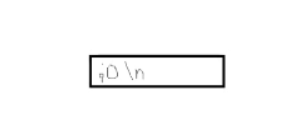
scanf is still in the buffer after reading \ n
So, char c; scanf("%c",&c); To remove the \ n
Initialization of character pointer and character array
#include <string.h> int main() { char* p="hello";//String constant"hello"First address assigned to p char c[10]="hello";//Equivalence and strcpy(c,"hello"); //c[0]='H'; printf("c[0]=&c\n",c[0]); printf("p[0]=&c\n",p[0]); //p[0]='H'; //The constant area data cannot be modified //p="world";//String world Address assigned to p //c="world";//illegal getchar(); system("pause"); return 0; }
//p[0]='H'; // The constant area data cannot be modified
Memory has permissions: r (read), w (write), rw
At this time, the memory in the address of p[0] is not writable
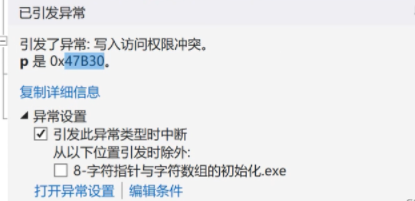
The string constant exists in the data area, which is neither heap nor stack. It needs memory to apply for reading and writing
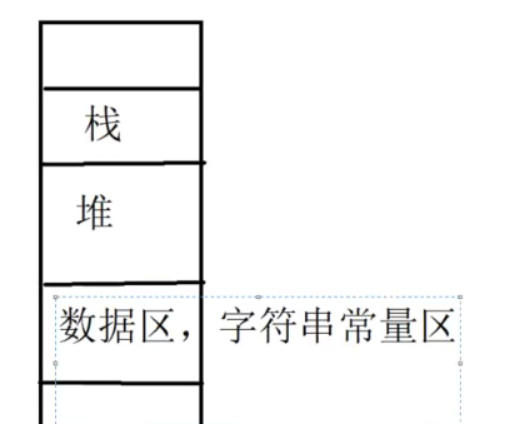
char c[10] ="hello world"
Take the string variable hello world from the data area to the stack
So it's readable and writable
So c[0] you can get 'H' from the data area
And pointer p[0]:
p[0]='H'; // The constant area data cannot be modified
At this time, 'H', in the data area, you cannot read variables or get the starting address,
Look again
p="world";// Assign the address of the string world to P
”"world" is a string data area. The starting address is
In this way, we can assign its starting address to p
//c="world";// illegal
c is an array. The address in it will not be changed and cannot be assigned directly
Secondary pointer
-
The secondary pointer only serves the transfer and offset of the primary pointer
-
To change the value of a variable in a subfunction, you must pass in the address of the variable
-
To change the value of a pointer variable in a sub function, you must pass in the address of the pointer variable
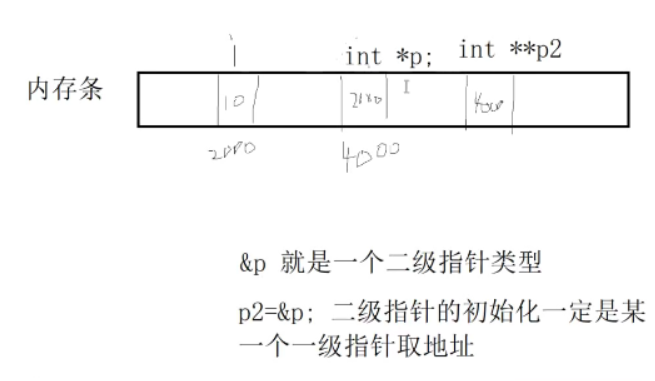
Like this, the second level pointer is that p is a pointer, * * p2 = & p; Get the original address of p
#define _CRT_SECURE_NO_WARNINGS #include <stdio.h> #include <stdlib.h> #include <string.h> void change(int** p,int *pj) { *p=pj; //*p Equivalent to pi } int main() { int i=10; int j=5; int* pi; int* pj; pi=&i; pj=&j; printf("i=%d,*pi=%d,*pj=%d\n",i,*pi,*pj);//Equal to 10, 10, 5 change(&pi,pj); printf("after change i=%d,*pi=%d,*pj=%d\n",i,*pi,*pj); //The goal is to make*pi The value of is 5 getchar(); system("pause"); return 0; }
